Join me as I teach you all about maintaining and feeding a sourdough starter. Every week I receive hundreds of questions about how to care for a sourdough starter, so I decided to add all the questions and answers into this post as a reference for those who are just starting out with sourdough.
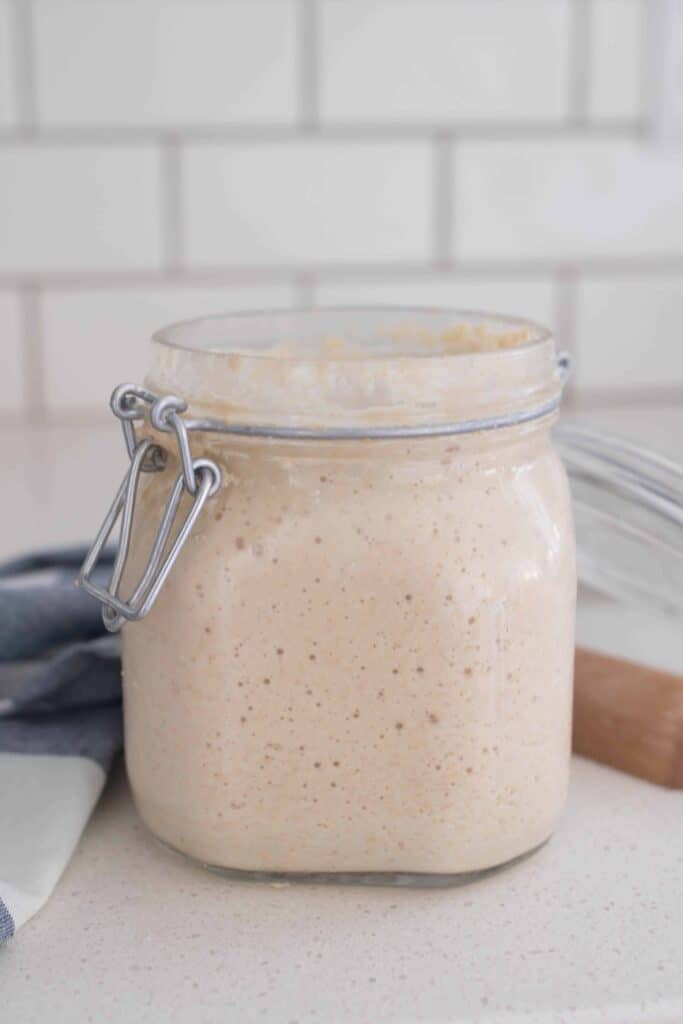
Table of Contents
- How To Feed A Sourdough Starter:
- Maintaining A Sourdough Starter:
- How Often Should I Feed my Sourdough Starter?
- Feeding a sourdough starter in the refrigerator
- How much flour and water should I feed my sourdough starter?
- Common Questions Regarding Maintaining and Feeding A Sourdough Starter
- What does “fed” sourdough starter mean when your recipes call for it?
- Is it okay to put my sourdough starter away unfed?
- My starter taste really sour. How can I make it so that it does not taste as sour?
- If I receive sourdough starter from a friend, how long should I wait to use it?
- How do you make sourdough starter?
- Do you know how to make gluten free sourdough starter?
- What is your schedule for sourdough starter?
- Is it normal for the sourdough starter to develop a hard crust over the top of it?
- What is the black layer of liquid on top of my sourdough called and why is it there?
- After day 7, do I keep discarding half of my sourdough starter?
- How do I know when my sourdough starter has gone bad or molded?
- How do I know my sourdough starter is working after it finished day 7?
- Why is sourdough starter much healthier than just regular flour?
- I cannot tolerate grains. Do you think that I will be able to tolerate sourdough starter?
- How long should a properly maintained sourdough starter be kept?
- Should sourdough starter be kept airtight?
- What is the difference between sourdough discard and starter?
- Can I leave sourdough dough out overnight?
- Can I let my sourdough rise in the fridge?
- What flour should I feed my sourdough starter?
- Find My Favorite Fermented Recipes:
Sourdough is such an integral part of our diet, and I have been maintaining and feeding a sourdough starter for 11 years. Warm, crusty bread straight out of the oven, or decadent desserts made from fermented grains – they are comforting to the soul.
When people hear sourdough, I think their mind usually thinks about how difficult it must be to maintain something like that. It’s just another thing to care for, and something else to think about in advance.
But I’m here to tell you just the opposite. Sourdough has made life, and cooking on the go, much easier. I’m not a meal planner, and I never have been. As long as I have some sourdough starter, there are so many recipes I can just whip up.
From waffles to pancakes, pizza to cobbler, and so many more (you can find my favorite no wait sourdough recipes here), you may not realize how many options there are!
I’ve been baking and cooking with sourdough for a long time, and some sourdough connoisseurs may not exactly like how I do it, but hey, it’s worked for me all these years without issue.
So, let’s get into how easy it is to maintain and feed a sourdough starter.
This post may contain affiliate links, which means I make a small commission at no extra cost to you.
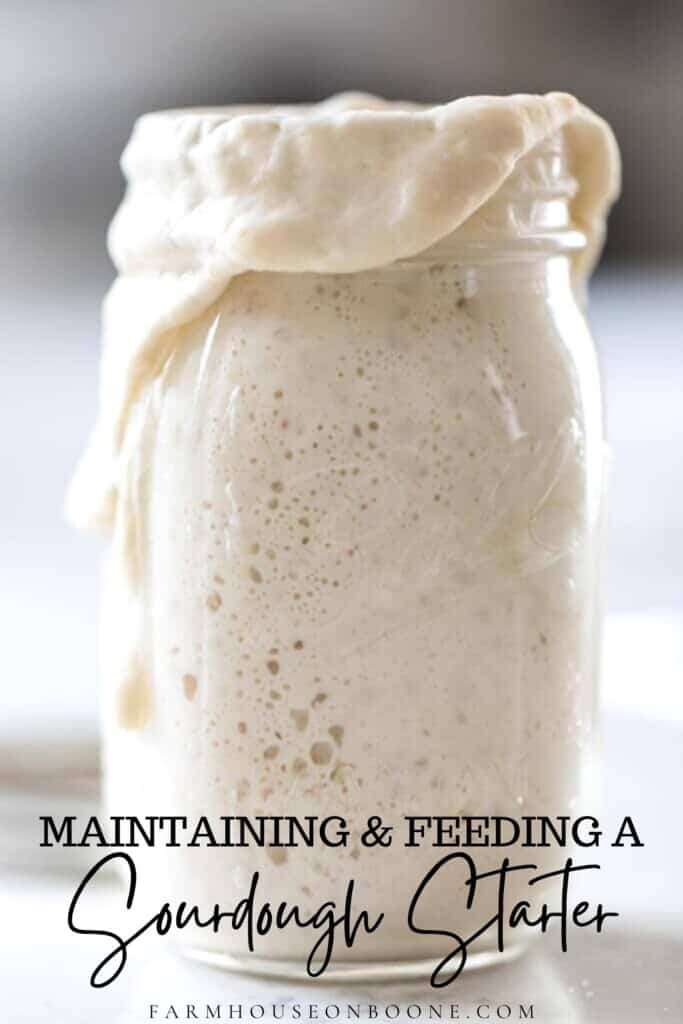
How To Feed A Sourdough Starter:
While there are fussy ways of doing this, I’m going to show you how I’ve done it for years without any issues.
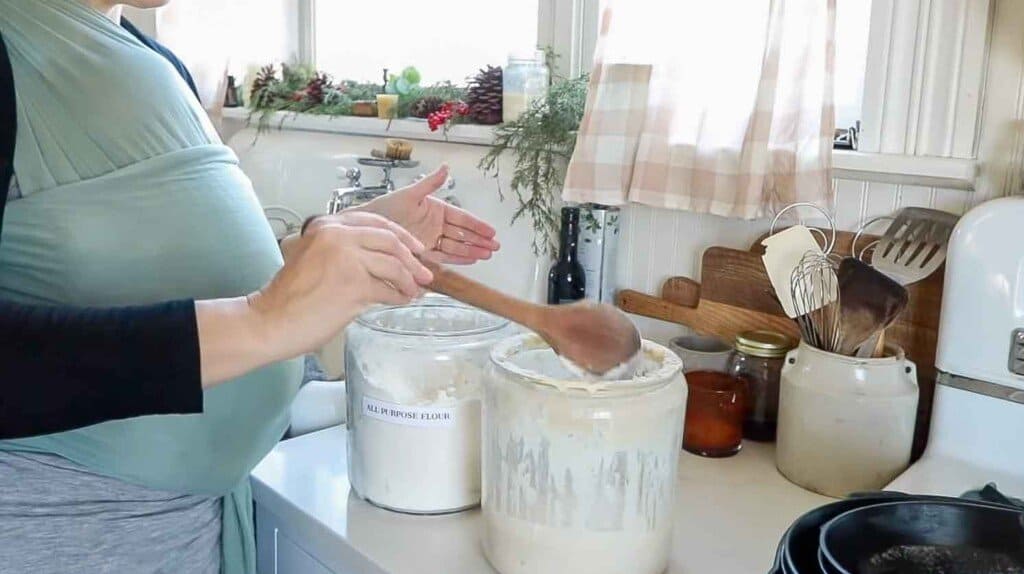
I like to start by eyeballing approximately how much sourdough starter I already have and feeding it at least that much in equal parts of flour and water. For example, if you have about 1 cup of sourdough starter, you will want to feed it at least 1/2 cup water and 1/2 cup flour.
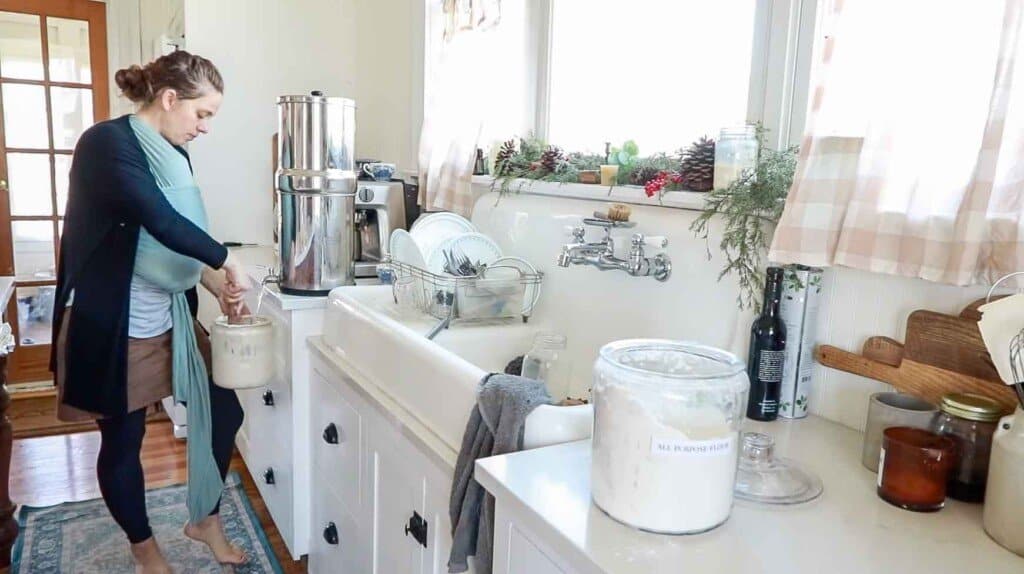
If I’m running low on starter, I will add more than the minimum requirement of flour and water.
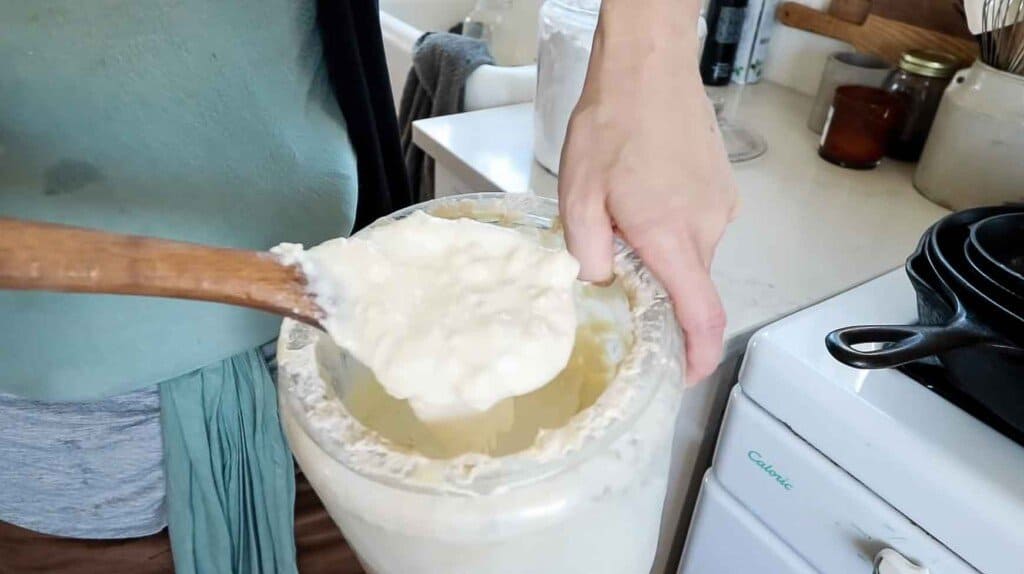
Mix it up. The consistency should be similar to pancake batter.
Cover with either a tea towel or a glass lid. I like using a glass lid, because a towel tends to get really messy.
Allow to sit of for 4-12 hours before using in a recipe, once it has about doubled in volume. If not using for baking, feed about 12-24 hours after last feeding or place in the fridge.
Maintaining A Sourdough Starter:
Maintenance is fairly simple. Like anything living, it requires food and water. The location you keep your starter in will determine how you maintain it.
Leaving it out on the counter, it will need to be fed equal parts water and flour every 12-24 hours. Warmer homes or frequent baking will require more frequent feeding (around every 12 hours), while colder homes every 24 hours.
Storing your sourdough starter in the fridge will require feeding around once a week. It can, however, be stored up to two months in the fridge without being fed.
Reviving a sourdough starter that has been stored in the fridge for a longer period of time is a good idea. This can be done by feeding it equal parts flour and water, allowing it to sit at room temperature for 12 hours, and then feeding it again.
It may need to be fed 2-3 times for 12 hours between each feeding before it becomes active enough to make certain recipes like bread. Some no-wait recipes you may be able to use sooner.
Pour off any hooch (if there is any, see below) before feeding.
How Often Should I Feed my Sourdough Starter?
That totally depends on how often you are going to use it.
Say you are going to use your starter to make pancakes every morning, or english muffins or french toast. You can leave your starter out on your counter and just feed it every 12-24 hours.
I do not use my starter every day. I use it a few times a week, so what I do is keep it in the refrigerator in a bowl with an airtight lid or glass lid.
To illustrate, say that it is Friday, and on Saturday, I want to make pancakes. I will pull my sourdough out of the fridge on Friday and add some flour and water to the bowl, mix it up, and leave it on the counter with a tea towel covering it until Saturday morning.
Once I am done making pancakes on Saturday, and if I am not planning on using my sourdough starter until next week, I will feed it and leave it on the counter for 8 hours, then cover the bowl with an airtight lid and leave it in the refrigerator until next Friday.
However, let us say that I am planning on using my sourdough starter again on Sunday to make cinnamon rolls, then I will just feed the sourdough starter and leave it on the counter until Sunday.
When you leave sourdough on the counter at room temperature, the yeast will again be nice and active, and it will become bubbly sourdough starter.
Feeding a sourdough starter in the refrigerator
When you put your starter in the refrigerator, it puts the starter on pause, so you do not have to feed it as often because the yeast will relax and they do not need much sustenance. You can kind of think of it like a bear hibernating in the winter.
When the sourdough starter is in the fridge, it does not need to be fed as much as it does when it is on the counter. On the counter, it needs to be fed daily, but in the fridge, it only needs to be fed once a week.
You can even switch back and forth between the refrigerator and the counter if you use it sporadically.
If you use the starter every day, leave it on the counter. When not using it for two weeks, leave it in the refrigerator.
How much flour and water should I feed my sourdough starter?
Sourdough starters are really resilient. I have had mine for 11 years now and I never measure the flour and water. I just add enough to make the starter the consistency of thick pancake batter.
It’s not something I worry about, and it is a very happy, healthy sourdough starter.
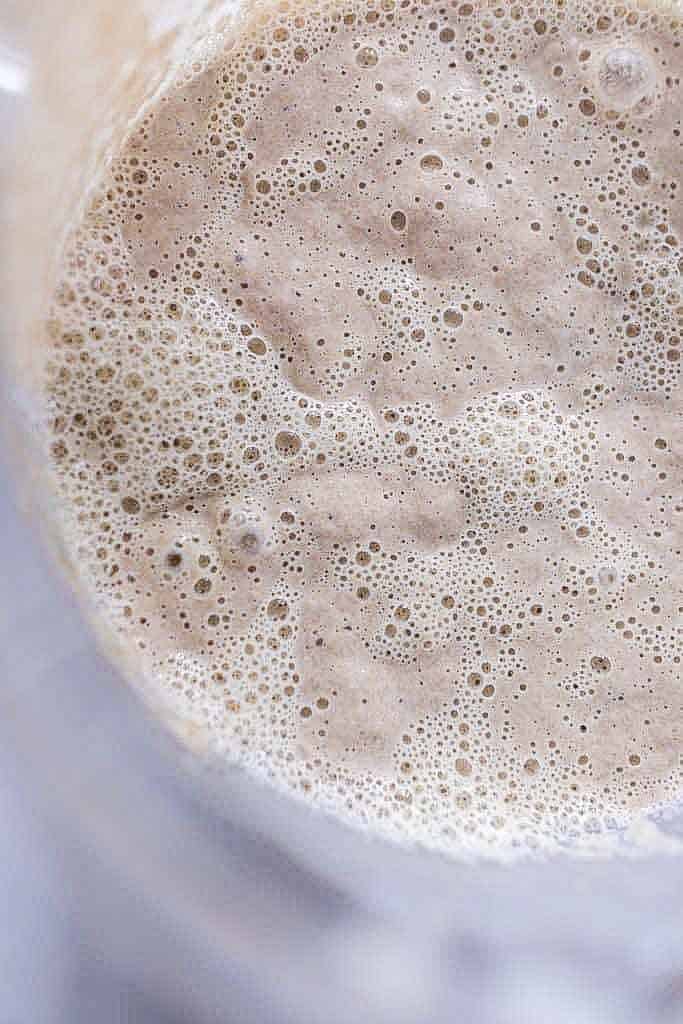
Common Questions Regarding Maintaining and Feeding A Sourdough Starter
Once the initial 7 or so days is up, how often does it need to be “fed” if you’re keeping it on the counter top?
How often you should feed your starter depends on how much you use it during the week. I would keep it in the fridge if you only use a few times a week.
A good idea is to feed it every time you use it, leave it on the counter for 8 hours, and then put it back into the fridge until you are ready to use it again.
How long before I intend to use it do I need to take it out of the fridge?
Typically, the suggestion is to wait at least 4 hours. But this also depends on what you are making. If you are following a sourdough recipe, usually the author should tell you exactly when to do so.
Many times, I will just take it out of the fridge and use it right away.
Should you bake sourdough straight from the fridge?
This will depend on the type of recipe. Many no-wait recipes that call for discard will have no problem at all using a starter straight from the fridge.
But for other recipes, like bread, for best results I suggest taking it out of the fridge, feeding it, and allowing it to be nice and active before using it. This usually takes about 4-12 hours.
My sourdough is really thick and pasty – is it supposed to be like that?
No, it is not. If your sourdough starter is really thick, then just add a little more water until it is the consistency of thick pancake batter.
In the “How to Make Sourdough Starter” blog post, I give you the guideline of a 1:1 ratio of flour to water. However, that is just a guideline.
The real ratio depends on what type of flour you are using. If you are using an all-purpose flour, then you can get away with a smaller amount of water, but if you are using a whole grain wheat flour, you may need more water.
The basic principle is that some flours soak up water more than other flours, so the best way to find out how much flour to water you need is to just play around with it.
Why do I have to discard half of my sourdough starter? Instead of discarding half of my sourdough starter on Days 2-7, can I just use it to make another separate sourdough starter?
That question doesn’t actually make sense to me, because what you are creating is basically a symbiotic colony of yeast that you capture from your local environment. What you are trying to do is just make a master starter that can then inoculate anything else with the yeast colonies that are in it.
Therefore, you do not need to create more than one. It is basically just like having double the sourdough starter which, once you have an established starter, you can easily do by just adding more flour and water to the bowl of sourdough starter.
It is really hard to explain, but basically what I am saying is all that you are throwing away, when you discard half of your sourdough starter on days 2-7, is flour and water. Just think of it that way.
There is really no way else to make sourdough starter, because what you have is immature starter at that point, and there is not much that you can do with it.
This is particularly true if you are making a sourdough starter because you cannot really tolerate grains, so what you have there is not yet fully fermented.
If you are trying to avoid grains that are unfermented, you are just going to want to discard it. You can put it in your compost or feed it to your animals.
It is not like you are throwing away perfectly good sourdough starter. I hope that makes sense!
How do you store your sourdough starter?
When you are feeding you starter, you will leave it out on the counter where it can get a little bit of air, so you might cover it with a thin tea towel or something else that is not air tight. Cover for a few hours before putting it back in the fridge.
However, when it goes in the refrigerator, you are going to want to use something airtight. I personally keep my starter in a 2.5 quart glass bowl, and I cover it with a silicone lid. This is what I have always done.
On occasion, I have to take the sourdough starter out and clean the bowl really well, because things get really crusty up on the top of the bowl and I do not want that.
How much sourdough starter do you keep on hand?
I always like to keep a pretty good amount of starter in the bowl, because there are certain no-wait sourdough recipes that you can make, like my sourdough skillet and sourdough Dutch baby pancakes.
If you have enough in your bowl that you can pull from, you can always make those recipes without having to wait as long as the starter is fed and full.
Now you always want to keep enough sourdough starter in the bowl that you can use to feed again to continue on having sourdough starter.
As long as you can remove enough for your recipes while leaving about a cup of starter in your bowl, you can feed it and get it back to a full bowl of starter.
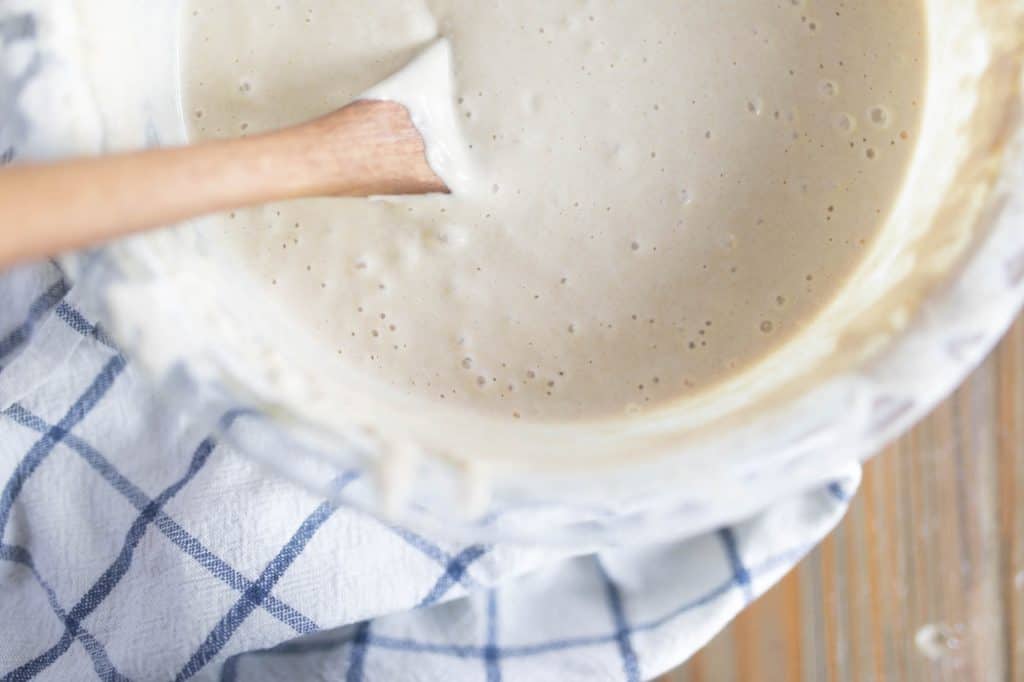
What does “fed” sourdough starter mean when your recipes call for it?
What I mean by that is your sourdough starter has had flour and water and the opportunity to sit out and feed on that.
If you are going to feed your starter, let’s say it is out of the fridge, you give it flour and water and stir it up really well. You do not want to instantly put it back in the fridge, even if you are not planning to use it.
You want to let the starter sit out for a few hours to feed and be active for a little bit, then cover it and put it back into the refrigerator.
Now, at that point, you could pull it out of the fridge the next day and use it for pancakes and sourdough skillet and it has been fed.
Is it okay to put my sourdough starter away unfed?
I do not usually like to put my sourdough starter away unfed, but I am not saying I haven’t done it and still worked out just fine.
Once, after I made pancakes on Saturday morning, I put my sourdough starter straight into the fridge without feeding it first. I didn’t feed it at all until the next Friday when I pulled it out to feed it again in preparation for Saturday morning pancakes, and it was totally fine.
However, ideally, you want to give the starter some flour and water, let it sit out on the counter for a few hours, and then put it in the fridge.
So, obviously, there are way less rules to keeping sourdough starter than you might think. As you keep your starter, you will get really familiar with it.
My starter taste really sour. How can I make it so that it does not taste as sour?
Your starter may have a little bit of a smell if it hasn’t been fed in a while, and your cooking projects will taste a little more sour to reflect that.
So if you want to avoid the super sour sourdough taste, you might just need to feed it more often and not let it sit out on the counter as long.
However, if you are sort of intolerant to grains, you are at least going to want to let it sit out for 24 hours to do all the fermenting work.
If you are just trying to get a little bit of the sourdough taste and a little bit of that fermentation, you can let it ferment for a lot less time and avoid a lot of that sourdough taste, but it will not have the full benefit of the fermented grains.

If I receive sourdough starter from a friend, how long should I wait to use it?
I would say just feed it once and let it bubble up before using it.
How do you make sourdough starter?
Funny you should ask! I actually have a post all about that here: How to Make for Sourdough Starter.
Do you know how to make gluten free sourdough starter?
Yes, after much experimentation I successfully created a Gluten Free Sourdough Starter and shared all the steps in this post here.
What is your schedule for sourdough starter?
I honestly do not even have one. Every week is different. Sometimes, I only use my sourdough starter one day and leave it in the fridge for a week, and then the next week, I use it everyday.
Is it normal for the sourdough starter to develop a hard crust over the top of it?
Yes! Whenever you have your sourdough sitting out on the counter with something that is not air tight, like a tea towel, it is totally normal. You can either scrape off the hard sourdough starter or stir it in.
What is the black layer of liquid on top of my sourdough called and why is it there?
It is called hooch. You can either dump it out or stir it in. Most likely, your sourdough starter is hungry and needs to be fed, so just give it some more flour and water and it should be fine.
After day 7, do I keep discarding half of my sourdough starter?
Nope! Once the sourdough starter is established on day 8, all you have to do is just give it flour and water. You no longer need to discard half of it.
How do I know when my sourdough starter has gone bad or molded?
Honestly, that is a case by case basis. I get a lot of questions about this, but I don’t really know if your sourdough starter is molded or bad until I see it.
So, honestly, I do not know. I do know that your sourdough starter should not have an offputting smell, but it does have a sour smell to it. You should definitely be able to see if there is mold.
How do I know my sourdough starter is working after it finished day 7?
You will know it is working if it works in your recipes. For example, if you are making sourdough bread and you make the dough, put it in a nice warm spot, and if it doesn’t rise, that means your starter is not fully established and you need to keep on making it.
Or you just need to throw it away and start over.
Your sourdough starter should definitely rise if it is good and active. You will also see a lot of bubbles on the top.
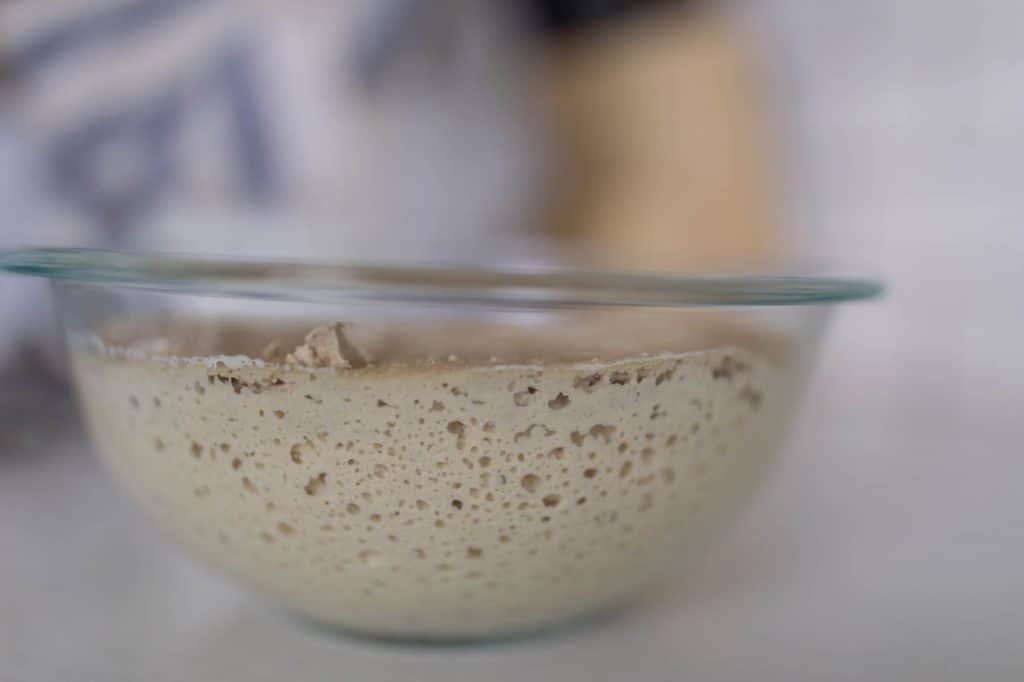
Why is sourdough starter much healthier than just regular flour?
This has to do with the grains and the fermentation. A lot of people today cannot tolerate grains. For the most part, a lot of people have given up grains and they are going gluten free and grain free.
I am not a doctor or a food expert, but I can tell you what I know about it.
Outside of a grain, there is a protective layer called phytic acid. That phytic acid is very incompatible with your body absorbing and digesting those grains.
When you ferment those grains, the fermentation process takes care of that pre-digesting work for you.
It makes the grains, and the nutrients in them, more easily accessible for your body to recognize and use without having to go through those original steps of breaking down the phytic acid. This process can be very taxing and difficult for your body.
Plus, fermentation just makes the nutrients more readily available. What was locked up inside the phytic acid in the grain, the outside of the bran, is now available for your body to use.
A lot of the vitamins that are in the grain are not actually doing you any good until fermentation unlocks them.
A lot of the time, people who cannot tolerate grains find that they can tolerate sourdough starter if it has at least sat out on the counter for 24 hours.
I cannot tolerate grains. Do you think that I will be able to tolerate sourdough starter?
You may be able to tolerate grains that have been fermented for 18 to 24 hours. This may take some playing around with. A friend of mine couldn’t tolerate unfermented grains at 12 hours, but 18 hours was the magic number.
However, if you have celiac, you should completely avoid gluten grains, fermented or not. Definitely check with your doctor.
How long should a properly maintained sourdough starter be kept?
A properly maintained sourdough starter can literally be kept for over a hundred years and passed down from generation to generation.
Should sourdough starter be kept airtight?
It doesn’t need to be in an airtight container, but it does need to have some sort of lid to help protect it from bugs or dust.
What is the difference between sourdough discard and starter?
They technically are the same thing. The difference is when a recipe calls for discard or active sourdough starter.
Discard refers to an unfed starter, or a starter that was fed, had risen, and is needing fed again but isn’t being used. It is also a term used when people toss out starter before feeding. At this point, I never discard any of my starter because of the frequency I use it in many recipes that call for just “discard“.
Active, on the other hand, is when it has been fed and has had time to get nice and bubbly.
Can I leave sourdough dough out overnight?
Yes, while most recipes will call for room temperature fermentation for at least 8-12 hours, some recipes can be fermented at room temperature for 24 hours without issue. Just make sure to cover the dough.
Can I let my sourdough rise in the fridge?
Yes. Some recipes, like bread or long fermented recipes with egg, call for rising in the fridge. This slows the fermentation time way down. Many breads can be successfully risen in the fridge up to 36 hours without over proofing.
What flour should I feed my sourdough starter?
Unbleached all-purpose, whole wheat (I use freshly ground flour), and even einkorn works just fine. I find that my starter is highly adaptable and does just fine with any of those types of flour.
Find My Favorite Fermented Recipes:
- Sourdough Chocolate Rolls
- Easy Sourdough Flatbread
- Sourdough Strawberry Shortcake
- Mascarpone Stuffed Sourdough French Toast Casserole
- Fluffy Sourdough Biscuits
- Sourdough Garlic Bread
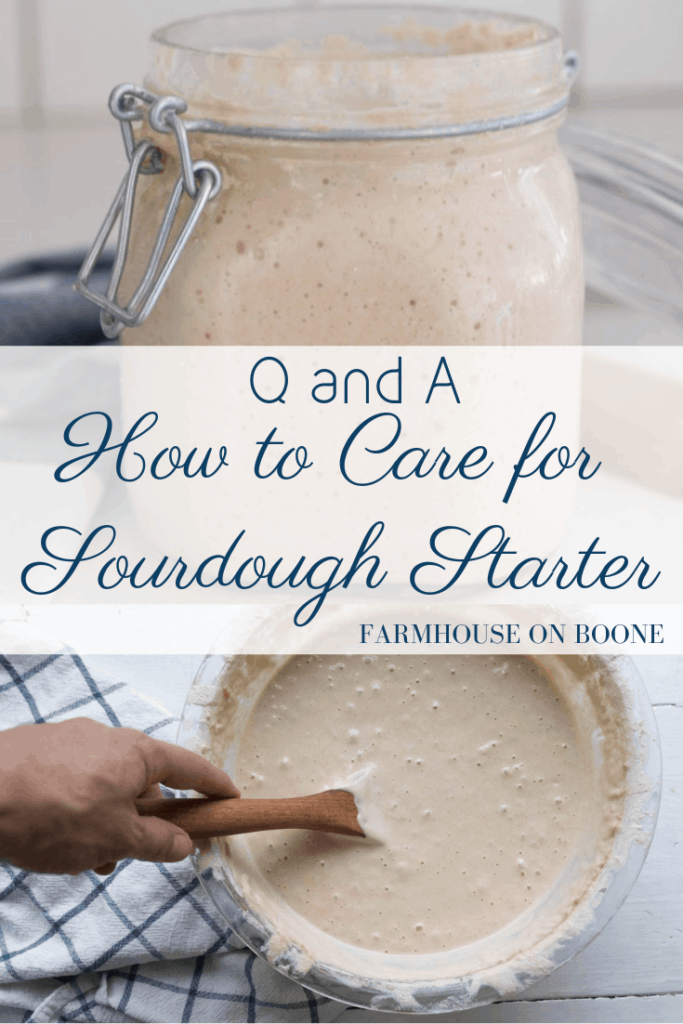
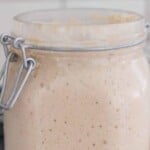
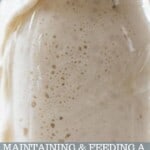


















I am almost 4 weeks into my starter and I’ve only had it doubled in size a few times. I have attempted bread three times now and it is heavy, dense and flat. The best luck I’ve had at having it rise is feeding it half amount of rye flour, half amount of all purpose. I will admit I have not tried the float test. My house is really cool. I finally have added it to a heating pad to see if this helps but I’m almost 4 weeks in. And when I have made bread, it is so incredibly sticky anyways, I just don’t know what I’m doing wrong!!
It sounds like temperature could definitely be an issue. Is your starter rye and AP, or was it solely rye? That could also be why your starter may be struggling to rise. I would work on getting the temperature perfect for your starter.
Hello I have about 3/4 cup of sourdough starter and I use it to make bread every other day and use 1/2 cup of the starter, when I’m done using it I feed it half a cup of flour and 1/3 cup of water till pancake consistency, I always have the same amount in my jar but when a recipe calls for 2 cups of sourdough starter I don’t have enough, how can I make more?
Just feed it more before you need to use it.
My kitchen is super cold ususally because cool air leaks throught the sliding glass door, so Ive been trying to use a heating pad that is actually for seed starters. Is that too warm? If I leave it sitting on that for long periods of time it gets a crust on top but if I dont, it doesnt want to rise or bubble at all because of my chilly house. I guess my question is, how should I handle the starter when my house is so chilly. My oven does not have the light bulb setting to use.
A seed starting mat is perfect for your starter! It has a much lighter heat than a traditional heating pad. Some people even wrap Christmas lights around the jar of their starter to help give it a boost.
If it’s been 24 hours since feeding but the starter is still bubbly, is it good to use in a bread recipe? Or should I feed it, then after several hours use it in a recipe?
I would still use it if it has bubbles!
Thanks so much for your video on starter. Very helpful.
My question is this: 1. Sometimes you use the term “starter” and i think it is “discard”. What is the difference? It seems if you use the starter without it doubling it is discard? I thought everytime I feed my starter i need to discard 50%. Sometimes i just put the discard in the refrigerator but perhaps that is just starter that is sleeping….
Thanks.
Discard is starter that is not fully active and bubbly, basically starter that needs fed. I have many recipes that you can use discard straight from the fridge.
My sour dough bread always burns black on the bottoms. I have tried a few things but still is black. I cut that off to make it easier to eat. Do you have any suggestions?
Have you tried adding rice underneath the parchment paper?
I have yet to see my sourdough starter float. What is going on? I’m just getting started from a friends starter that she passed along. It stayed in the fridge for a week, I pulled it out and fed it a little, but the next morning, it hadn’t done much. I left it out on the counter, fed it again, and saw it rise then fall. When I tested a blob, it did not float.
Did you test it during the rise? That’s when it will float. If it is rising and falling with bubbles, it should be ready to use.
Hey Lisa! I’ve been keeping a starter going for weeks & months now. Problem is… it will not double by the 4-6 hr mark. It’s slow in rising. I don’t understand. I use KA bread flour & rye. Rye is the only way I can get it moving faster. But I’m worried it won’t raise a loaf? Can I still use it for a recipe & just let the loaf rise longer?
I normally say double by 4-12 hours. But some starters may take longer than others and if you have a cooler house it could take even longer. You for sure could still use it in recipes, they may take longer to rise.
Ok so my starter.after I feed it will rise and fall then smell like alcohol just after 4 hours of feeding it. What am I doing wrong? This is an already established starter.
Are you keeping it in a super warm spot? Temperature can affect how fast it rises and falls.
Hello!
My starter seems to always have an acetone smell to it. I’ve read that means it’s just hungry and to feed it but I’m accumulating a lot because I just established it. What do I do if I feed it and it still smells like acetone after it’s bubbled and rise? Leave it or feed??
You could try feeding and hydrating your starter a bit less. For example, 1 cup of flour to 3/4 cup water. That may help your situation.